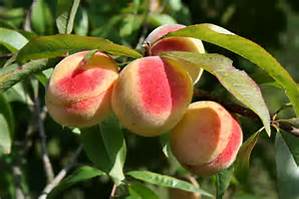The peach (Prunus persica) is a deciduous tree native to the region of Northwest China between the Tarim Basin and the north slopes of the Kunlun Shan mountains, where it was first domesticated and cultivated. It bears an edible juicy fruit called a peach or a nectarine.The major phenolic compounds identified in peach are chlorogenic acid, catechins and epicatechins, with other compounds, identified by HPLC, including gallic acid and ellagic acid. Rutin and isoquercetin are the primary flavonols found in clingstone peaches.
Red-fleshed peaches are rich in anthocyanins, particularly cyanidin glucosides in six peach and six nectarine cultivars and malvin glycosides in clingstone peaches. As with many other members of the rose family, peach seeds contain cyanogenic glycosides, including amygdalin. These substances are capable of decomposing into a sugar molecule and hydrogen cyanide gas. While peach seeds are not the most toxic within the rose family, large consumption of these chemicals from any source is potentially hazardous to animal and human health.
| Catalog | Product Name | CAS Number | Manual |
|---|---|---|---|
| CFN98373 | Amygdalin | 29883-15-6 | |
| CFN99916 | Beta-Sitosterol | 83-46-5 | |
| CFN97326 | Stigmasterol | 83-48-7 | |
| CFN92204 | Campesterol | 474-62-4 | |
| CFN97566 | Prunasin | 99-18-3 | |
| CFN97994 | Cycloartanol | 4657-58-3 | n/a |
| CFN99370 | 24-Methylenecycloartanol acetate | 1259-94-5 | |
| CFN98713 | Daucosterol | 474-58-8 | |
| CFN99769 | D-(+)-Glucose | 50-99-7 | |
| CFN99116 | Chlorogenic acid | 327-97-9 | |
| CFN97472 | Neochlorogenic acid | 906-33-2 | |
| CFN92393 | 3-O-Feruloylquinic acid | 1899-29-2 | |
| CFN93168 | Linoleic acid | 60-33-3 | |
| CFN98970 | Sucrose | 57-50-1 | n/a |
A unique collection of 33 natural compounds from Scutellaria barbata D.Don
A unique collection of 21 natural compounds from Aucklandia lappa
A unique collection of 23 natural compounds from Curcuma longa L.
A unique collection of 25 natural compounds from Rheum palmatum L.
A unique collection of 22 natural compounds from Inula Britannica L.
A unique collection of 21 natural compounds from Rubia cordifolia L.





